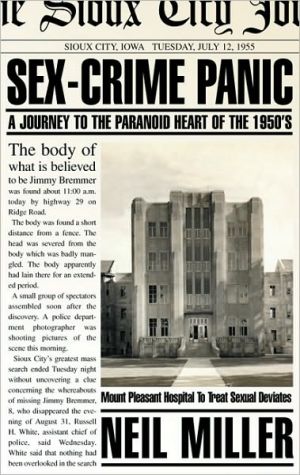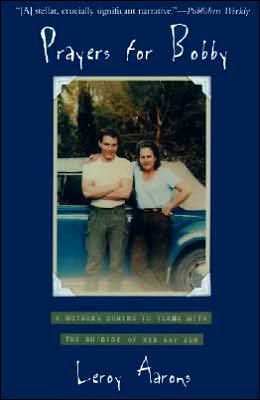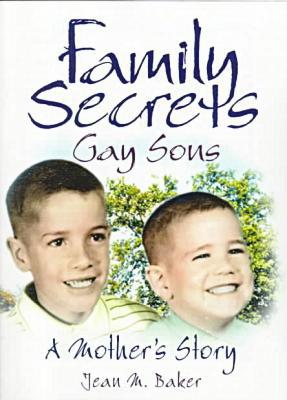Sex-Crime Panic: A Journey to the Paranoid Heart of the 1950s
Following the brutal murders of two children in Sioux City, Iowa, in 1954, police, in an attempt to quell public hysteria, arrested 20 men whom the authorities never claimed had anything to do with the crimes. Labeled as sexual psychopaths under an Iowa law that lumped homosexuals together with child molesters and murderers, the men were sentenced to a mental institution until cured. Their shocking story is brought to light for the first time by award-winning journalist Neil Miller, author of...
Search in google:
How did two horrific murders lead to the incarceration of 20 gay men? Publishers Weekly It started in 1955 with a missing eight-year-old boy, Jimmy Bremmers, later found murdered, and the arrest and conviction of Ernest Triplett, a simpleminded Sioux City, Iowa, salesman, for the crime. But within months public hysteria caused the police to arrest 20 middle-class gay men who were charged with being "sexual psychopaths," although none had anything to do with the murder, and who were incarcerated for prolonged periods of time in a state mental hospital. Miller (Out in the Worlds: Gay and Lesbian Life from Buenos Aires to Bankok) has produced a cross between a fast-paced true-crime shocker and a biting expos of 1950s sexual hysteria. While there are still plenty of missing details (many of those involved who are still living were reluctant to talk or had only vague memories), Miller's story has enough chilling facts to pack a wallop: while under arrest, Triplett was given huge amounts of "experimental" drugs (LSD and amphetamine) to help him remember the murder, and his enjoyment of Liberace was used against him in court. Although he supplies a cohesive social context how McCarthyism linked communism and homosexuality as twin "enemies within" along with a similar, but far larger, homosexual scandal that occurred simultaneously in Boise, Idaho the stories of Triplett and of the 20 others arrested never quite come together. Still, Miller, a Tufts University professor and Lambda award winner, paints a disturbing picture of what it meant to be gay in mid-century America. (Jan.) Forecast: Miller's careful archival and interview work here makes the book suitable for courses in history and sociology, an angle Alyson intends to take up with course adoption mailings. The title shouldfind the gay history readership, and the faux lurid title, heightened by a tabloid-like cover, may draw in browsers. Copyright 2001 Cahners Business Information.
\ \ \ \ Chapter One\ \ \ A Boy Is Missing\ \ \ When Jimmy Bremmers disappeared the year before, on the last day in August 1954, Doug Thorson was far away. He was in the service then, working air-to-ground on the president's plane at Andrews Air Force base. Duane Wheeler was in Sioux City starting cosmetology school. Of course, Duane read about the missing boy in the papers. Everyone did, you couldn't avoid it. But Duane was too absorbed with learning about hair color and the roller set and mastering the intricate art of the permanent wave. What did it have to do with him, after all? As for Jimmy's parents—they were building their dream house.\ The afternoon of the day it happened, Joseph and Dorothy Bremmers were laying brick for the basement. Mr. Bremmers had taken a week off from his job. It was the Tuesday before Labor Day, and he had a seemingly uninterrupted stretch of time ahead of him. He hoped to make some progress on the house while the weather stayed warm and the days were still long.\ The house was in a new subdivision, just across the road from the bluffs of the Loess Hills. At this time of year the bluffs were covered with tall prairie grasses and plants with names like wild rose and yucca and blazing star. The sumac that climbed the crest of the hills would soon change color, turning the landscape into a brilliant, heart-piercing red, if only for a moment. Today, a 13-foot-high steel statue of War Eagle, the Santee chief who befriended the first white men to come to northwest Iowa, looked out from one of the high bluffs across theMissouri River into the open country of Nebraska and South Dakota. But in 1954 the War Eagle memorial was just a slab of stone, frequently vandalized, and the silty bluffs were mainly a place for beer parties and stolen kisses.\ The Bremmerses were building their new house out of reddish concrete block, almost as handsome as brick but cheaper and easier to construct. The house would be solid, modern—ranch style, with a roomy garage and even a picture window. There would be plenty of space for the family's three children—Karen, 14; Patricia, 12; and Jimmy, who had just turned 8. There was no doubt about it: The Bremmerses were moving up in the world.\ Mr. and Mrs. Bremmers were doing most of the work on the house themselves; the family income was modest, and contractors were expensive. Mr. Bremmers had been employed by the Metz Baking Company in Sioux City since the end of the war. He had risen through the ranks to his current position as stock clerk, checking the trucks as they left to deliver bread and other baked goods. At 35, he was a rough-looking but handsome man, with dark hair and large working-man's hands. He had labored steadily on the basement that entire afternoon. Mrs. Bremmers had gone home to fix dinner, returning at about 5:30 to drive him home.\ While the new house was under construction, home was still the one-story bungalow at 2701 Cottage Avenue in a lower-middle-class neighborhood on the fringes of Sioux City's west side, where the Bremmerses had lived since 1944. The area was sparsely populated and almost rural in character: Cottage Avenue and most of the streets around it were little more than dirt lanes shaded by cottonwood and walnut trees. Across the street from the Bremmers's property was a hay field; there was a cornfield next door, and behind the house was rolling pasture. The nearby houses all had large vegetable gardens.\ At dinner Mr. Bremmers joked with his son, Jimmy. A friend had asked Jimmy for their address, and as Mr. Bremmers later recalled, Jimmy had confused the numbers.\ "Well, Jimmy, you gave him the wrong address," his father remonstrated gently.\ "Huh, I did, huh?" Jimmy stammered.\ Jimmy had a slight speech impediment; in the slang of the day, he was a little "dutch" or "dutchy." He was a quiet and obedient boy who never gave his parents a moment of worry; he never stayed out after dark, and if he and the boys he played with were planning to do anything beyond their usual routine, he always told his mother. Jimmy was beginning second grade at Emerson School the following Tuesday. His closest companion was his black-and-white dog, Specks, who was devoted to Jimmy and slept curled up beside him every night. Before Jimmy, Mrs. Bremmers had miscarried six sons; after all that pain and loss, he was particularly precious, the baby of the family.\ After dinner, Mr. and Mrs. Bremmers returned to the new house to do some more work. It was a perfect late summer evening, cloudless and still warm, with one of those heavenly breezes that sweep across the Great Plains, full of fragrance and possibility. At the Capitol Theater on Nebraska Street, Seven Brides for Seven Brothers was playing. The Turin Inn at 11th and Steuben was offering a special on steak dinners, starting at $1. In the American League, the Cleveland Indians were five and a half games ahead of the Yankees, on their way to a first-place finish that they wouldn't repeat for 41 years. That day in Washington, D.C., the Senate committee investigating Wisconsin senator Joseph McCarthy's tactics in ferreting out alleged Communists in the U.S. Army was issuing a report critical of McCarthy; the full Senate would censure him two months later. The Red scare that had gripped the country almost since the end of the war was finally starting to wind down.\ Most nights, Jimmy went along with his parents to help with the house, but tonight he was going to visit his friend Joey Hamel, two doors away on Prescott Street. Mrs. Bremmers didn't give Jimmy's plans much thought; Jimmy's oldest sister Karen would be playing baseball with some girlfriends in the side yard and promised to keep an eye on him. Anyway, it was the kind of neighborhood where everyone looked after everyone else's kids. During the day, when their husbands were off at work, the women—none of whom worked outside the home—would stop by each other's houses for coffee and gossip. No one locked houses or cars. There was little coming and going or foot or automobile traffic. If there was a stranger in the neighborhood, everyone knew it immediately.\ At the Hamels', a group of boys were gathered in front of a television set. Television was new in Sioux City in 1954 and still the object of much excitement. The Sioux City station was presenting Make Room for Daddy, an early version of the Danny Thomas Show; the Omaha channel, the only other one you could pick up in Sioux City, offered Juvenile Jury, in which a panel of five children solved real-life problems. Among the boys watching TV that night was Steve Counterman, Joey Hamel's cousin. He was 13, older than Jimmy, but he and Jimmy and Joey Hamel would still play together—"cowboys and Indians" and "trucks." Jimmy joined the group for a while, but he seemed restless. He kept wandering in and out of the house.\ At 8 P.M., just as Life with Father came on, the phone rang. It was Steve Counterman's mother. The family was going visiting in Morningside, a neighborhood on the other side of town, and Mrs. Counterman wanted Steve to come along.\ It was growing dark, and in the surrounding houses, lights had started to come on. As Steve was leaving, he saw Jimmy standing all alone by a fir tree in front of the Hamel's porch. Jimmy was wearing blue jeans, a gray gabardine belt, and a pair of high-topped shoes that his mother had bought him the Friday before; he didn't have a shirt on—it was that warm. Steve ran up the hill toward home, but something made him stop for a moment and look back. In the waning light he could still make out Jimmy standing next to the tree. He was just standing there, Steve would repeat later with disbelief. That was all he was doing, just standing there. They called good night to each other, and Steve continued on his way.\ No one who knew him ever saw Jimmy Bremmers alive again.\ \ \ After the war and into the early '50s, a lot of things went wrong in Sioux City. Just before Christmas 1949, a gas explosion at the Swift packing plant in the stockyards killed 20 people and injured close to 100. To this day, old-timers say that some of the survivors are still at Cherokee, the state mental hospital, somewhere between the living and the dead. In 1952 came the Missouri River flood, one of the worst in the city's history. And then in '53 the Floyd River overwhelmed its banks, advancing right to Fourth and Nebraska streets in the heart of downtown; 14 people drowned. The polio epidemic hit Sioux City very hard as well—almost 1,000 cases in Woodbury County in 1952, the peak year of the epidemic nationwide. Summer, so beautiful in northwest Iowa and so easy and carefree, became a season of dread because of polio.\ In those days Sioux City was an important metropolis—the second biggest city in Iowa, with 83,991 people, according to the 1950 census. Established in 1854 as a frontier settlement along the Missouri, Sioux City owed its early prosperity mostly to the real estate and railroad boom of the 1880s and 1890s; within a decade its population had soared from 19,000 to near 50,000. During this period, the city's extravagant and now-legendary corn palaces were built. Great things were expected of Sioux City. It was going to be the next major metropolis of the Plains, "Little Chicago." Then came the panic of 1893, and the dreams were shattered. But if Sioux City's phenomenal growth came to an end, the stockyards and livestock markets established during this period continued to flourish for most of the next century.\ Through it all, a feeling of safety and security persisted. This is the middle of the country, after all, where trouble always seems far away, on the East or West coasts—never here where fields of corn and soybeans extend almost to the horizon. Sioux City was a working man's town, a family town, where church and high school sports were the major recreational activities. People could leave their doors unlocked and their windows open. Everyone seemed to know everyone else; everyone was, above all, "nice." There was a veneer of culture: a symphony orchestra, community theater, band concerts at Grandview Park in summer, right out of a Midwestern dream; and two colleges—Morningside and Briar Cliff. The town had just celebrated its centennial the month before. It was filled with many young families like the Bremmerses—war vets and their wives and children—looking hopefully toward the future.\ This was the 1950s, a decade of optimism. The interstate highway system was on its way, replacing Iowa's infamous "concrete cow paths." Sioux Cityans would soon be able to drive to Omaha—the nearest large city—in an hour and a half and to Des Moines in a little more than three. Problems could be fixed: Engineers dammed and rechanneled the volatile Floyd River; Woodbury County was one of the first places in the United States chosen to test the Salk polio vaccine. Eisenhower was president; he was a reassuring figure—he hadn't suffered his heart attacks yet.\ But the sense of safety and security began to break down that late summer evening in 1954, when Jimmy Bremmers didn't return home. Things like that weren't supposed to happen in Sioux City in those days. Some will tell you that's when the town first really came face-to-face with the ugliness and unpredictability of the modern world.\ \ \ Jimmy Bremmers was the object of the biggest search in Sioux City history. Beginning on Wednesday, the day after he had disappeared, hundreds of national guardsmen and troops from the nearby Air Force base combed the landscape a mile in every direction from the Cottage Street house. Sometimes they searched with their hands joined together, as if to ward off some unknown evil. An Iowa Army National Guard helicopter—with Mr. Bremmers as a passenger—buzzed overhead. On Friday, guardsmen patrolled all the highways leading out of Sioux City. The head of the National Guard search team declared that they had checked every cave, cistern, well, garage, barn, shed, and brush pile in the area. But they found nothing.\ As the days passed without any sign of Jimmy, Mrs. Bremmers became increasingly convinced her son had been the victim of foul play. "I know somebody took him," she told The Sioux City Journal. "I don't think they'll find him anywhere around. Down in my heart I know Jimmy's been kidnapped." Her son had been so well behaved and obedient that there could be no other rational explanation. He had always obeyed her instructions never to take rides with strangers. "So I know that whoever took him had a struggle," she said. "A stranger would have to knock him on the head to get him into a car."\ On Thursday evening, two nights after Jimmy's disappearance, two of Mr. Bremmers's brothers stood vigil the entire night at the Bremmers's home with the lights out. Their hope was that someone with knowledge of the boy's whereabouts might leave a note or come to the door. This did not occur.\ Jimmy's friend Steve Counterman, who had seen him standing beside the fir tree in the waning August light, was particularly affected by Jimmy's disappearance. "It made me awful nervous when I found out he was gone," he said. "I wish I knew what happened. I pray for him to come back. Everybody's praying around here. I can't understand why he was just standing there."\ Meanwhile, reports of sightings of Jimmy began to filter in. Detectives in Omaha received a tip from a certain T.A. Cooper of Woodward, Iowa, near Des Moines, who told them he thought he had seen the boy at a café in Cedar Rapids three days after his disappearance. A boy whose description matched that of Jimmy Bremmers had entered the café with a middle-aged man who was dressed in a worn brown suit and had a disfigured left hand. Cooper said the man ordered a dish of ice cream for the boy, and the boy refused to eat it. The man told the boy, "Eat what your daddy tells you." The boy replied sharply, "You are not my father!" In the end nothing came of the report.\ In Friday's edition, three days following Jimmy's disappearance, The Sioux City Journal reported that the police were checking on the city's known morals offenders. There was a possibility, the newspaper wrote, that a "sex fiend" might have abducted the boy.\ \ \ Excerpted from SEX-CRIME PANIC by Neil Miller. Copyright © 2002 by NEIL MILLER. Excerpted by permission. All rights reserved. No part of this excerpt may be reproduced or reprinted without permission in writing from the publisher. \ \ \ \
AcknowledgmentsAuthor's Note on NamesProloguePt. 1Two MurdersCh. 1A Boy Is Missing3Ch. 2Enter Ernest Triplett12Ch. 3Truth Serum26Ch. 4"A Lover of Liberace" on Trial38Ch. 5The Body in the Cornfield62Ch. 6Needed: 25 Sexual Psychopaths76Pt. 2The RoundupCh. 7Pinched93Ch. 8Enemies Within105Ch. 9Naming Names112Ch. 10Morals Crusader124Pt. 3The Sexual Psychopath WardCh. 11The Arrival141Ch. 12The Men in the Pink Shirts153Ch. 13Dancing With Greta Garbo160Ch. 14Therapy176Ch. 15Matters of the Heart184Ch. 16The Power and The Glory189Ch. 17Christmas in Sioux City192Ch. 18Cured193Ch. 19Closing the Books205Pt. 4The Second RoundupCh. 20Fighting Back209Pt. 5The ReckoningCh. 21Crimes of the Past 1237Ch. 22Crimes of the Past 2248Pt. 6Sex-Crime Panic: Legacy of a Troubled PastCh. 23Sex-Crime Panic259Sex-Crime Panic Timeline295People Interviewed296Bibliography297Source Notes299
\ Publishers WeeklyIt started in 1955 with a missing eight-year-old boy, Jimmy Bremmers, later found murdered, and the arrest and conviction of Ernest Triplett, a simpleminded Sioux City, Iowa, salesman, for the crime. But within months public hysteria caused the police to arrest 20 middle-class gay men who were charged with being "sexual psychopaths," although none had anything to do with the murder, and who were incarcerated for prolonged periods of time in a state mental hospital. Miller (Out in the Worlds: Gay and Lesbian Life from Buenos Aires to Bankok) has produced a cross between a fast-paced true-crime shocker and a biting expos of 1950s sexual hysteria. While there are still plenty of missing details (many of those involved who are still living were reluctant to talk or had only vague memories), Miller's story has enough chilling facts to pack a wallop: while under arrest, Triplett was given huge amounts of "experimental" drugs (LSD and amphetamine) to help him remember the murder, and his enjoyment of Liberace was used against him in court. Although he supplies a cohesive social context how McCarthyism linked communism and homosexuality as twin "enemies within" along with a similar, but far larger, homosexual scandal that occurred simultaneously in Boise, Idaho the stories of Triplett and of the 20 others arrested never quite come together. Still, Miller, a Tufts University professor and Lambda award winner, paints a disturbing picture of what it meant to be gay in mid-century America. (Jan.) Forecast: Miller's careful archival and interview work here makes the book suitable for courses in history and sociology, an angle Alyson intends to take up with course adoption mailings. The title shouldfind the gay history readership, and the faux lurid title, heightened by a tabloid-like cover, may draw in browsers. Copyright 2001 Cahners Business Information.\ \ \ \ \ Library JournalResidents of Sioux City, IA, were stunned and shaken by two brutal child molestations and murders in 1954 and 1955. The shock and outrage that followed led to the roundup of 20 gay men, who were then committed to a psychiatric hospital as criminal sexual psychopaths. Journalist Miller (In Search of Gay America) has written a taut and engrossing account of this sad chapter in Sioux City's history. Miller covers the brutal crimes, the politics set against the backdrop of McCarthy-era paranoia, the difficulties of being gay in Sioux City, life in the sexual psychopath ward, and the long-term effects this sex-crime hysteria had on all involved. Miller then comes full circle, discussing the adoption of some form of "Megan's Law" in all 50 states in the 1990s. ("Megan's Law" requires convicted sex offenders to register with their local police departments.) Today, as in the 1950s, criminal sexual acts set off panic and hysteria. The challenge is how to protect citizens without trampling civil rights. Highly recommended for history collections and especially for those specializing in gay and legal history. Karen Sandlin Silverman, Ctr. for Applied Research, Philadelphia Copyright 2001 Cahners Business Information.\ \ \ Kirkus ReviewsHysteria blazes in the heartland, exposing gay men to the worst of their communities, in this examination of two mid-20th-century murders. In the early 1950s, two young children, Jimmy Bremmers and Donna Sue Davis, were brutally killed in Sioux City, Iowa. The ensuing mania provoked the groundless incarceration of dozens of gay men. Miller (Journalism/Tufts Univ.; Out in the World, 1992) sifts through the murder investigations, the roundups of innocent men, and the repercussions of these events on the lives of all concerned in the 50-plus years since then. Within this complex web of narrative, he captures a range of memorable personalities: the ostensibly liberal district attorney who prosecuted the gay men; the chief suspect in the case, a traveling salesman convicted of the Bremmers murder but freed many years later; and the all-American high-school English teacher who fought to clear his name and record after being arrested in a bathroom. By opening this painful chapter in American history, Miller showcases yet another example of panic ripping apart neighbors and neighborhoods, providing a timely reminder (given the current international situation) that hysteria destroys the freedoms Americans hold most dear. Unfortunately, it's all related in pedestrian prose that lumbers along with little spring in its galumphing steps. What should be a true-crime-based expose with a gay slant on mental institutions' cruelties deflates into a sequential narrative offering little insight beyond the obvious, little style beyond the prosaic. One of the footnotes of history that demands a full accounting.\ \







